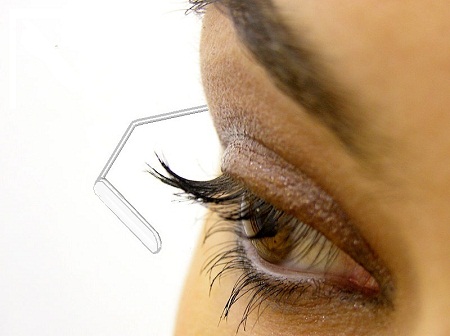One of the key elements of any eccescope is its display module — the part that actually directs images into your eye. Light doesn’t bend around corners by itself, so the question remains of how to direct those light rays into your pupil. One possibility is to take the concepts suggested by the Brother Airscouter, and push them to their limit. Here is my visualization of how such a display module might appear:

What is going on in this visualization is that components within the earpiece (not seen in this image, because they are blocked by the head) are generating a tiny collimated image that is directed to that little optical deflector you can see positioned in front of the eye. Different parts of this generated image are deflected by different parts of the optical deflector into the user’s pupil. The result is that collimated light rays enter the user’s pupil from different directions.
Like the Airscouter, this is a form of “retinal display”, since the user’s eye is left to do the work of converting those light rays from different directions into an image. In a retinal display, there is no physical display screen, just a virtual image that appears to be floating out in space, similar to the virtual image that you see when you peer into the eyepiece of a microscope or telescope.
With the proper engineering, a display module with this form factor is perfectly achievable. In fact, it might even be possible to create a display module that is even smaller. But there is more to an eccescope than its display module. It also needs to track — with high speed and accuracy — the user’s head position and orientation. Also, it is useful for the eccescope to gather information about what the user is looking at.
More to come.
Contact lenses? I tried multi-focal one (didn’t work for me)
Contact lenses turn out to be tricky, but interesting — I’ll discuss that in a forthcoming post.
Saw this and thought of you:
http://specials.forbes.com/photo/019m2is9FY7yT
Do you think general purpose eccescopy devices could grow naturally out of special purpose devices like this one? In the analogy with the bluetooth ear piece, most people don’t leave the ear piece on all day. The bluetooth ear piece really serves only one purpose, but you’ve shown a handful of different reasons to have an eccescope on all the time.
Interesting! I’d be more inclined to think that eccescopic devices will grow out of the emerging generation of SmartPhone augmented reality apps (like way-finding and identification of faces).
Eventually, if the form factor is right and performance (resolution, head tracking, latency) is good enough, people will start running those apps on extended Jawbone-like devices that include surrounding-contextual display, rather than needing to take out their SmartPhones.
Optical fiber approach might work in theory?